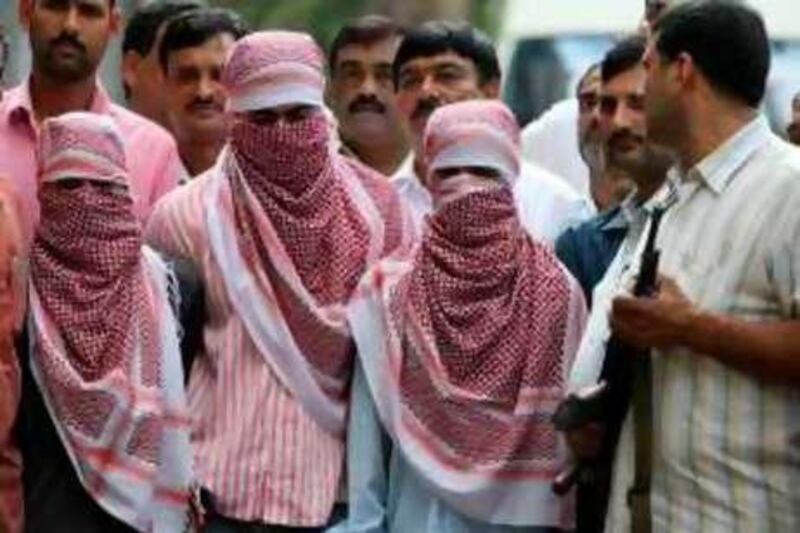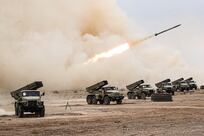NEW DELHI // India's National Human Rights Commission (NHRC) has ordered the Delhi police to provide details of last week's encounter in the city in which police claimed to have killed two Indian Mujahideen militants, including Atif Ameen, the alleged mastermind of recent serial blasts in New Delhi, Ahmedabad and elsewhere. The NHRC has given the Delhi police two weeks to provide details about the incident, after media, human rights activists and residents of Jamia Nagar, where the claimed encounter took place on Sept 19, alleged that it might have been fake and that the two dead Muslim youths might have had no connection with terrorism at all. Hassan Gafoor, police chief in Mumbai, which had asked the police in Delhi to monitor a mobile number they believe was being used by Ameen, said: "Delhi police botched up the whole operation, acting in a hurry."
Delhi police said yesterday they had targeted the Jamia Nagar flat where the "militants" were hiding after being tipped by Mumbai police. A fact-finding committee from the People's Union of Civil Liberties (PUCL), People's Union for Democratic Rights (PUDR) and Janhastakshep, a human rights group, following their visit to the spot of the encounter and verification of police versions of the shoot-out, called it a "fake encounter", staged by the police. Police said two militants had escaped from the scene after having shot a police inspector, who died on the way to a hospital.
"It is difficult to imagine how two alleged terrorists managed to escape from the building with only one exit, which was then surrounded by armed policemen," said Prashant Bhushan, a noted civil liberties lawyer. "If they were aware that they would be encountering armed terrorists in the house, why didn't Mr [Mohan] Sharma [the killed inspector] and his colleague wear bulletproof vests during the action - a must in every encounter?" he said. "Or, if the police didn't know they would end up facing armed militants or who were present in the house, how did they, hours after the shoot-out, declare that the mastermind had been killed and the blast case had been solved?" Adding that Sharma could have been accidentally killed by his own men, Mr Bhushan said: "The police version of the story appears to be totally false and concocted." Kamran Siddiqui, the chairman of Real Cause, which filed the first complaint to the NHRC, refuted the police version of Sharma's death. He said an autopsy report prepared by doctors at All India Institute of Medical Science showed all three bullets entered the police inspector's body from behind, and "it was most likely friendly fire". "Police said they recovered one AK-47 and pistols from the possession of the young men and only one pistol had been used by the militants to fire at Mr Sharma. If it was a real encounter, it is difficult to believe that the terrorists did not use the deadlier AK-47 and preferred to use a pistol to attack police," Mr Siddiqui said. In a series of reports following the encounter, popular national news channels AAJ TAK, Headlines Today and NDTV tried to show that the police version of the encounter was false and that some of the Muslim youths either killed in the shoot-out or arrested afterwards might have had no connection with terrorism. Reporters found that when police said Zeeshan Ahmed, a member of Indian Mujahideen, was alleged to be planting a bomb in New Delhi on Sept 13, he was actually taking an exam at the Indian Institute of Personnel Management. "If Zeeshan planted the bomb, why instead of running away from Delhi he came live on a TV channel in defence of his friends who had been branded terrorists?" NDTV asked. While arresting Saquib Nissar, Delhi police claimed the "Indian Mujahideen operative" had provided logistical support to the July 26 serial blasts in Ahmedabad. Television reporters found that from July 23 to July 28, he was busy taking an MBA examination in Delhi, and he was a top student in his class. After the autopsy of Mohammad Sajid, one of the two youths killed by police in the shoot-out, doctors reported that the 17-year-old boy had received sharp wounds and internal injuries in his stomach that were probably caused by violent physical assault. Jamia Nagar's residents said the alleged Sept 19 incident did not take place as police described, and police killed the two unarmed young men after beating them. The killing of unarmed people or accusations of fake encounters or staged gun battles are not new in India. Last year in the country's supreme court, Gujarat state government admitted that Gujarat police had killed Sohrabuddin Sheikh and his wife, Kauser Bi, in a fake encounter. In 2005, Sheikh was gunned down near Ahmedabad by an antiterrorist squad, which claimed Sheikh was a Lashkar-e-Tayyaba terrorist and he had planned to assassinate Narendra Modi, Gujarat's chief minister. Because Bi had witnessed her husband's execution, she was killed and her body was burnt by the police to destroy evidence. In 2002, a Dubai-based Indian software engineer, Syed Khwaja Yunus, was picked up by Maharastra police in Mumbai on suspicion of being involved in a train bombing. Two years later Mumbai High Court found 14 personnel of Maharastra police guilty of killing Yunus. Although police claimed Yunus was a terrorist involved in the bombing of a local train and had escaped from custody, an investigation found he had been murdered by police in Jan 2003. In March 2000, Indian army officials in Kashmir announced they had killed five Pakistani Lashkar-e-Tayyaba militants in a "fierce encounter". Following complaints by Kashmiris, India's Central Bureau of Investigation investigated the case and a DNA test found that the army had killed five Indian Muslim villagers, in a faked gun battle. In Kashmir, thousands of people have been killed in fake encounters since the beginning of 1990s, activists report.
In Mumbai and Delhi, police have so-called "encounter" specialists - officers unofficially assigned the task of summary executions of criminals. Daya Nayak, Mumbai's star encounter specialist, had been hailed as a hero for shooting dead 86 gangsters over five years. But in 2006 he was suspended after being charged with corruption. In August, another Mumbai encounter specialist, sharpshooter Pradeep Sharma - with 112 killings to his credit - was also suspended on similar charges of corruption. Activists and analysts say security forces across India have carried out thousands of extrajudicial killings and almost in all cases the modus operandi is the same: fake encounters in which authorities maintain they were forced to fire in self-defence or to prevent suspects escaping. The majority of the victims have been young Muslim men in their 20s or 30s. "Who has given policemen the licence to kill? Obviously the federal and state governments which condone extrajudicial killings, third-degree methods and police excesses," said Praful Bidwai, a New Delhi-based political analyst. Prem Shankar Jha, a well-known columnist, said: "The situation is exacerbated because in almost all cases we are forced to accept the police version of the facts. Hardly do we get a fair and transparent inquiry in such a case ? the actions [by police in Jamia Nagar] show a tremendous lack of respect for human lives." K Bhattacharya, an activist with Janhastakshep, wrote in a report that competition among various police agencies to claim credit for arresting terrorists is resulting in the targeting of Muslim youth. Other analysts charge that by parading suspects in the terrorist blasts masked in kaffiyehs as Delhi police did last week, they acted in a communally biased way and the action stems from a prejudiced belief that terrorism has its root in Islam. J Akbar, a veteran journalist, said about the use of kaffiyeh on the accused: "Indian Muslims did not need to open a political dictionary to gauge the meaning of this forced symbolism. They knew it was an attempt to stigmatise the whole community and link terrorism in India with an international conspiracy, with an implied hint at Osama bin Laden, the most famous Arab terrorist." As expected, Muslims are angry with police for singling them out as suspects in terrorist incidents. "I don't say that Muslims cannot be behind any of these bombings [in India]. But why is the whole community targeted and hundreds of innocents are being picked up and tortured by police?" said an elderly villager in Azamgarh, the north Indian town from where most of the Delhi bomb blast suspects hail. "If they continue to persecute us this way, the country has to prepare for a much bigger showdown soon." * The National





